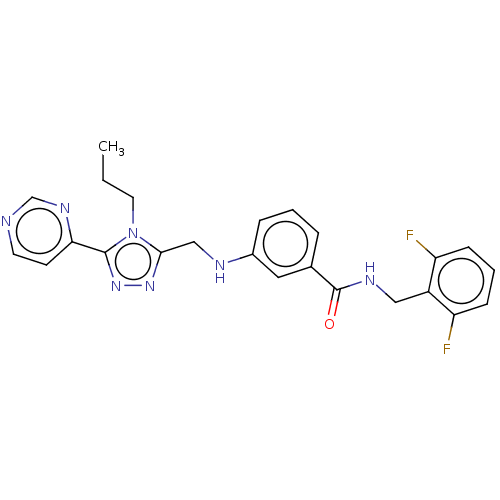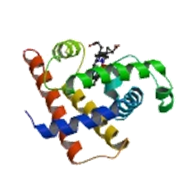BDBM50173313 CHEMBL1738878
SMILES CCCn1c(CNc2cccc(c2)C(=O)NCc2c(F)cccc2F)nnc1-c1ccncn1
InChI Key InChIKey=VWBSMGFTNCQOMB-UHFFFAOYSA-N
Activity Spreadsheet -- Enzyme Inhibition Constant Data from BindingDB
 Found 11 hits for monomerid = 50173313
Found 11 hits for monomerid = 50173313
Affinity DataIC50: 2.20E+3nMAssay Description:Inhibition of GRK5 (unknown origin) using tubulin as substrate by SDS-PAGE methodMore data for this Ligand-Target Pair
Affinity DataIC50: 9.00E+3nMAssay Description:Inhibition of GRK1 (unknown origin) using tubulin as substrate by SDS-PAGE methodMore data for this Ligand-Target Pair
Affinity DataIC50: 250nMAssay Description:Inhibition of human PKCalpha active using MBP as substrate after 60 mins in presence of [gamma-32]ATP by scintillation countingMore data for this Ligand-Target Pair
Affinity DataIC50: 1.20nMAssay Description:Inhibition of recombinant human N-terminal GST-tagged GRK2 expressed in baculovirus expression system using ulight topo2alpha as substrate preincubat...More data for this Ligand-Target Pair
Affinity DataIC50: 190nMAssay Description:Inhibition of recombinant human N-terminal GST-tagged ROCK2 catalytic domain (1 to 553 residues) expressed in baculovirus expression system using STK...More data for this Ligand-Target Pair
Affinity DataIC50: 20nMAssay Description:Inhibition of GRK2 (unknown origin) in presence of ATP at 5 uMMore data for this Ligand-Target Pair
Affinity DataIC50: 20nMAssay Description:Inhibition of GRK2 (unknown origin)More data for this Ligand-Target Pair
Affinity DataIC50: 2.20E+3nMAssay Description:Binding affinity towards norepinephrine transporter determined using [3H]nisoxetine as radioligandMore data for this Ligand-Target Pair
Affinity DataIC50: 20nMAssay Description:Inhibition of bovine GRK2 S670A mutant after 5 mins in presence of ATP by phosphorimaging assayMore data for this Ligand-Target Pair
Affinity DataKd: 2nMAssay Description:Binding affinity to full length human GRK2 by Thermofluor thermal shift assayMore data for this Ligand-Target Pair
Affinity DataIC50: 9.10E+3nMAssay Description:Inhibition of bovine GRK1 (1 to 535 residues) after 5 mins after 5 mins in presence of ATP by phosphorimaging assayMore data for this Ligand-Target Pair

 3D Structure (crystal)
3D Structure (crystal)